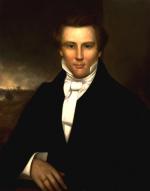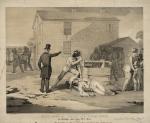![header=[Marker Text] body=[Founder of Mormonism, once lived a few miles East of here prior to 1830. Much of the translation of the "Golden Plates" for the Book of Mormon is said to have been done there. Site now owned by the Church of Latter Day Saints. ] sign](http://explorepahistory.com/kora/files/1/10/1-A-4F-139-ExplorePAHistory-a0a2z0-a_450.gif)
Mouse over for marker text
Name:
Joseph Smith
Region:
Poconos / Endless Mountains
County:
Susquehanna
Marker Location:
US 11 between Great Bend & Hallstead
Dedication Date:
May 15, 1947
Behind the Marker
Sweat soaked the shirts of the party of diggers. They had started with enthusiasm, each contributing his labor and money for a clairvoyant's supposed vision of buried Spanish treasure. It was 1825, and the digging was taking place on a farm in the Susquehanna Valley near Damascus, New York, just north of the Pennsylvania state line.
As they dug deeper and deeper, with no sign of the riches they had so eagerly anticipated, the men's mood began to darken. When the clairvoyant, a nineteen-year-old from New York named Joseph Smith, told them that an "enchantment" was causing the treasure to sink deeper into the ground, they cried foul. Surely, they'd been fools to trust a fortune-teller who said he saw the treasure through a magic stone.
In spite of this early failure, Joseph Smith did not give up a belief in his own magical powers. He remained in the Susquehanna Valley, at a farm in Pennsylvania, and courted the daughter of Isaac Hale, one of the treasure seekers. Hale called Smith an "arrogant, fraudulent, and lazy" young man, unfit to claim his daughter's hand. But Smith persisted, visiting Emma in secret, and in January 1827, when he turned twenty-one, Smith convinced her to elope with him. The couple returned to her family's home the following fall to collect her belongings. Joseph begged his father-in-law's forgiveness and promised to lead an honest and responsible life. Hale took him at his word, and Joseph and Emma Smith moved into a small house on the farm.
But Joseph's explorations with clairvoyance continued. One day, when he didn't show up to help with chores as expected, Hale went to investigate. What he discovered alarmed him. Joseph told him that he had been visited by an angel, who directed him to a set of buried golden plates inscribed with mysterious symbols. Smith claimed these plates made up a holy book, called The Book of Mormon. Although the symbols were seemingly indecipherable, Joseph had found two stones buried with the plates, which he was using to translate the symbols into English.
To her father's consternation, Emma sat quietly nearby, transcribing Joseph's translations. As his father-in-law watched, Joseph placed these two supernaturally endowed stones, which he called Urim and Thummim, into his hat and then covered his face with it. He refused to show his father-in-law the golden plates, and Hale once again fumed that his son-in-law was a fraud. But there was a change in Joseph. He soberly told Hale that although the golden plates were worth a great deal, he valued them only for their message.
It took Joseph Smith two and a half years to complete his translation. Announcing that the angel had returned to take the plates "off to eternity," he took his manuscript to a printer, and on March 25, 1830, The Book of Mormon: An Account Written by the Hand of Mormon upon Plates Taken from the Plates of Nephi appeared in a local bookstore. Joseph's translation told the story of Jewish people who had migrated to America from the Holy Land, centuries before the birth of Jesus Christ, and were the ancestors of the American Indians.
Local ministers called Smith's Book of Mormon blasphemous, but many people were intrigued by the incorporation of American history into Biblical history, thereby uniting religious and patriotic sentiments. At a time when western New York was a hotbed of evangelical ferment, Smith attracted zealous converts to his new religion.
Joseph Smith soon began to promote his vision. Unlike the "fire and brimstone" message of many of his contemporaries, he described a life, a picture of eternal happiness in a Biblical land of milk and honey. In 1830, he founded the Church of Jesus Christ of Latter-day Saints, and as his religious community grew, he, like so many non-conformist religious leaders before him, began to seek a home where his flock could practice their faith undisturbed.
After a series of false starts in Ohio and Missouri, tragedy befell Smith in Illinois as local farmers accused him of seducing their wives. Though the sheriff locked Smith up while investigating these claims, local residents sought their own brand of justice, dragged the prophet from his jail cell, and murdered him. Despite this ill-fated event, the majority of Smith's followers maintained their belief in the promises of the Book of Mormon. They followed Mormon Apostle Brigham Young on an arduous journey across the Great Plains to the Great Salt Lake Valley in Utah, where they settled and prospered.
From its start on a farm near Great Bend in Pennsylvania's Susquehanna County, the Church of the Latter Day Saints has grown into a world-wide religious movement with more than ten million members. Joseph Smith's visions provided the foundation for a successful on-going missionary movement and a strong church community in the Salt Lake area.
As they dug deeper and deeper, with no sign of the riches they had so eagerly anticipated, the men's mood began to darken. When the clairvoyant, a nineteen-year-old from New York named Joseph Smith, told them that an "enchantment" was causing the treasure to sink deeper into the ground, they cried foul. Surely, they'd been fools to trust a fortune-teller who said he saw the treasure through a magic stone.
In spite of this early failure, Joseph Smith did not give up a belief in his own magical powers. He remained in the Susquehanna Valley, at a farm in Pennsylvania, and courted the daughter of Isaac Hale, one of the treasure seekers. Hale called Smith an "arrogant, fraudulent, and lazy" young man, unfit to claim his daughter's hand. But Smith persisted, visiting Emma in secret, and in January 1827, when he turned twenty-one, Smith convinced her to elope with him. The couple returned to her family's home the following fall to collect her belongings. Joseph begged his father-in-law's forgiveness and promised to lead an honest and responsible life. Hale took him at his word, and Joseph and Emma Smith moved into a small house on the farm.
But Joseph's explorations with clairvoyance continued. One day, when he didn't show up to help with chores as expected, Hale went to investigate. What he discovered alarmed him. Joseph told him that he had been visited by an angel, who directed him to a set of buried golden plates inscribed with mysterious symbols. Smith claimed these plates made up a holy book, called The Book of Mormon. Although the symbols were seemingly indecipherable, Joseph had found two stones buried with the plates, which he was using to translate the symbols into English.
To her father's consternation, Emma sat quietly nearby, transcribing Joseph's translations. As his father-in-law watched, Joseph placed these two supernaturally endowed stones, which he called Urim and Thummim, into his hat and then covered his face with it. He refused to show his father-in-law the golden plates, and Hale once again fumed that his son-in-law was a fraud. But there was a change in Joseph. He soberly told Hale that although the golden plates were worth a great deal, he valued them only for their message.
It took Joseph Smith two and a half years to complete his translation. Announcing that the angel had returned to take the plates "off to eternity," he took his manuscript to a printer, and on March 25, 1830, The Book of Mormon: An Account Written by the Hand of Mormon upon Plates Taken from the Plates of Nephi appeared in a local bookstore. Joseph's translation told the story of Jewish people who had migrated to America from the Holy Land, centuries before the birth of Jesus Christ, and were the ancestors of the American Indians.
Local ministers called Smith's Book of Mormon blasphemous, but many people were intrigued by the incorporation of American history into Biblical history, thereby uniting religious and patriotic sentiments. At a time when western New York was a hotbed of evangelical ferment, Smith attracted zealous converts to his new religion.
Joseph Smith soon began to promote his vision. Unlike the "fire and brimstone" message of many of his contemporaries, he described a life, a picture of eternal happiness in a Biblical land of milk and honey. In 1830, he founded the Church of Jesus Christ of Latter-day Saints, and as his religious community grew, he, like so many non-conformist religious leaders before him, began to seek a home where his flock could practice their faith undisturbed.
After a series of false starts in Ohio and Missouri, tragedy befell Smith in Illinois as local farmers accused him of seducing their wives. Though the sheriff locked Smith up while investigating these claims, local residents sought their own brand of justice, dragged the prophet from his jail cell, and murdered him. Despite this ill-fated event, the majority of Smith's followers maintained their belief in the promises of the Book of Mormon. They followed Mormon Apostle Brigham Young on an arduous journey across the Great Plains to the Great Salt Lake Valley in Utah, where they settled and prospered.
From its start on a farm near Great Bend in Pennsylvania's Susquehanna County, the Church of the Latter Day Saints has grown into a world-wide religious movement with more than ten million members. Joseph Smith's visions provided the foundation for a successful on-going missionary movement and a strong church community in the Salt Lake area.







